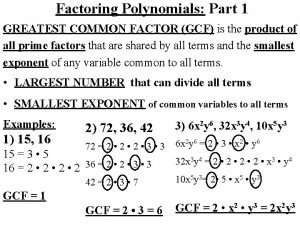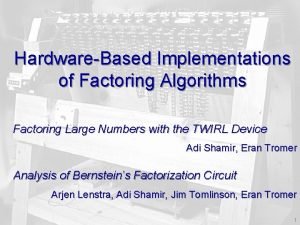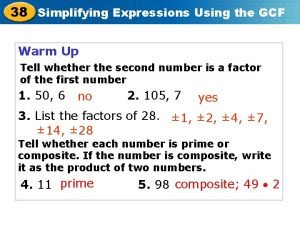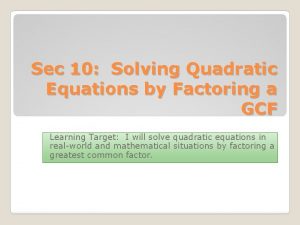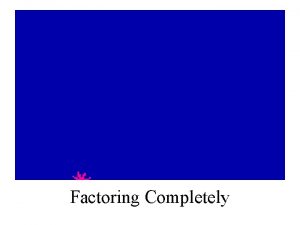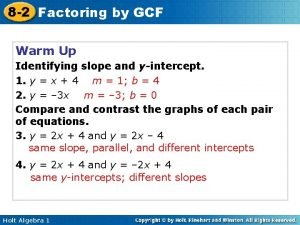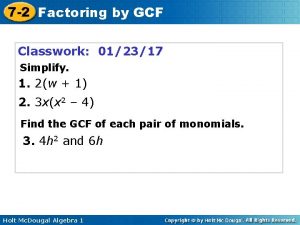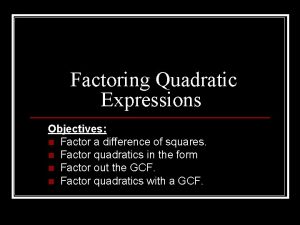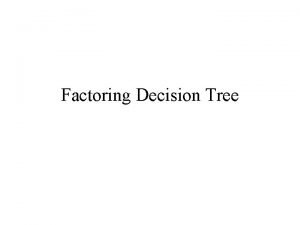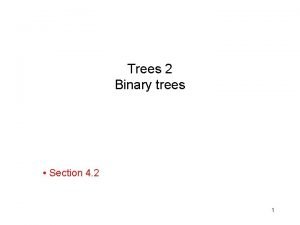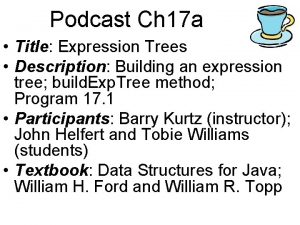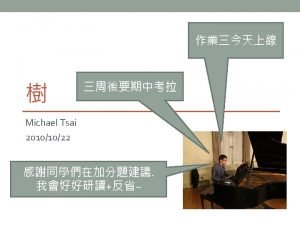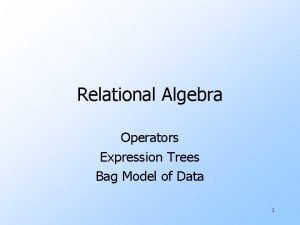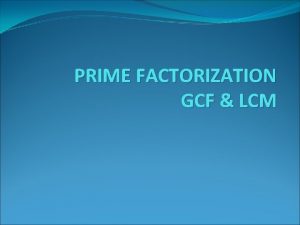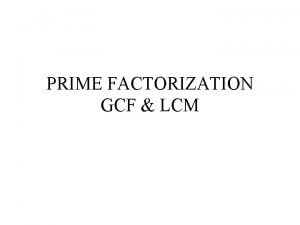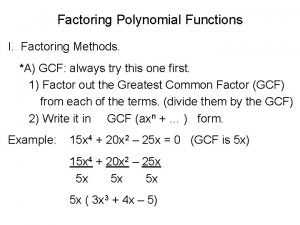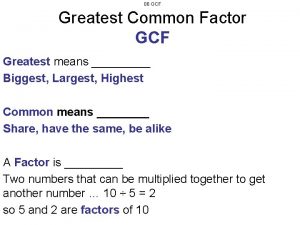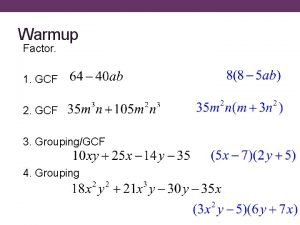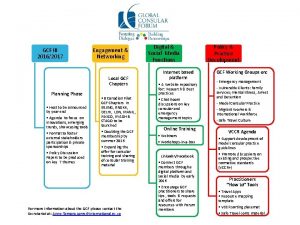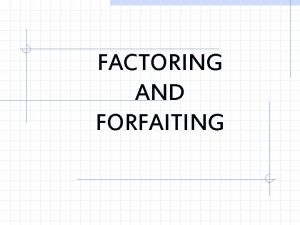Factoring Decision Tree Factoring Decision Tree Expression GCF

























- Slides: 25

Factoring Decision Tree

Factoring Decision Tree Expression GCF

Expression Step 1 GCF 14 x + 21 = 7(2 x + 3) 9 x – 12 y = 3(3 x – 4 y) 2 2 x + 6 x + 4 = 2 2(x + 3 x + 2) 5 ab 2 + 10 a 2 b 2 + 15 a 2 b = 5 ab(b + 2 ab + 3 a)

Factoring Decision Tree Two Terms Binomial Difference of Squares Expression GCF Count the number of terms

Difference of Squares • If the polynomial has two terms (it is a binomial), then see if it is the difference of two squares. a 2 – b 2 = (a + b)(a – b) x 2 – 9 = (x + 3)(x – 3) • Remember the sum of squares will not factor in the real numbers. a 2 + b 2

Using FOIL we find the product of two binomials.

Rewrite the polynomial as the product of a sum and a difference.

Factoring Decision Tree Expression GCF Count the number of terms Two Terms Binomial Three Terms Trinomial Difference of Squares Special Pattern

Special Patterns Using FOIL we find the product of two binomials.

Rewrite the perfect square trinomial as a binomial squared. So when you recognize this… …you can write this.

Recognizing a Perfect Square Trinomial • First term must be a perfect square. (x)(x) = x 2 • Last term must be a perfect square. (5)(5) = 25 • Middle term must be twice the product of the roots of the first and last term. (2)(5)(x) = 10 x

Recognizing a Perfect Square Trinomial • First term must be a perfect square. (m)(m) = m 2 • Last term must be a perfect square. (4)(4) = 16 • Middle term must be twice the product of the roots of the first and last term. (2)(4)(m) = 8 m

Recognizing a Perfect Square Trinomial • First term must be a perfect square. (p)(p) = p 2 • Last term. Signs must bemust a perfect square. match! (9)(9) = 81 • Middle term must be twice the product of the roots of the first and last term. (2)(-9)(p) = -18 p

Recognizing a Perfect Square Trinomial Not a perfect square trinomial. • First term must be a perfect square. (6 p) = 36 p 2 • Last term must be a perfect square. (5)(5) = 25 • Middle term must be twice the product of the roots of the first and last term. (2)(5)(6 p) = 60 p ≠ 30 p

Factoring Decision Tree Two Terms Binomial Expression Count the number of terms Three Term Trinomial Difference of Squares GCF Not a Special Pattern Leading Coefficient = 1 Special Pattern Grouping

Grouping: Start with the trinomial and pretend that you have a factorization. This means that to find the correct factorization we must find two numbers m and n with a sum of 10 and a product of 24.

Factoring a Trinomial by Grouping First list the factors of 24. Now add the factors. Rewrite with four terms. 1 24 25 2 12 14 3 8 11 4 6 10 Notice that 4 and 6 sum to the middle term.

Factoring a Trinomial by Grouping First list the factors of 24. Now add the factors. Rewrite with four terms. 1 24 25 2 12 14 3 8 11 4 6 10 Notice that 2 and 12 sum to the middle term.

Factoring Decision Tree Two Terms Binomial Expression Count the number of terms Three Term Trinomial Difference of Squares GCF Not a Special Pattern Leading Coefficient = 1 Special Pattern Leading Coefficient ≠ 1 Grouping

Coefficient a ≠ 1 First list the factors of 2∙(-38) = -76. Now subtract the factors. 1 76 75 2 38 36 4 19 15 Notice that 4 and 19 do the job. Rewrite with four terms.

Factoring Decision Tree Two Terms Binomial Expression Count the number of terms Three Term Trinomial Difference of Squares GCF Not a Special Pattern Leading Coefficient = 1 Special Pattern Leading Coefficient ≠ 1 Grouping Inspection

Inspection • Guess at the factorization until you get it right. • Check with multiplication. • With practice this is the quickest.

Factoring Decision Tree Two Terms Binomial Expression GCF Grouping Count the number of terms Three Term Trinomial Difference of Squares Four Terms Not a Special Pattern Leading Coefficient = 1 Special Pattern Leading Coefficient ≠ 1 Grouping Inspection

Four Term Grouping • If the polynomial has more than three terms, try to factor by grouping.

Factoring Decision Tree Two Terms Binomial Expression GCF Grouping Count the number of terms Three Term Trinomial Difference of Squares Four Terms Not a Special Pattern Leading Coefficient = 1 Special Pattern Leading Coefficient ≠ 1 Grouping Inspection
 The greatest common factor of 9x^2y 27xy^2 and 45x^2y^2
The greatest common factor of 9x^2y 27xy^2 and 45x^2y^2 Factor the expression using the gcf. $4m+32$
Factor the expression using the gcf. $4m+32$ Factor the simplified expression using the gcf.
Factor the simplified expression using the gcf. Objectives of decision making
Objectives of decision making Financial management process
Financial management process Solving quadratic equations by gcf worksheet
Solving quadratic equations by gcf worksheet Gcf factoring polynomials
Gcf factoring polynomials Gcf in factoring
Gcf in factoring Factoring tool
Factoring tool Lesson 8-2 factoring by gcf
Lesson 8-2 factoring by gcf Gcf warm up
Gcf warm up Factoring using the gcf
Factoring using the gcf Lesson 8-2 factoring by gcf
Lesson 8-2 factoring by gcf Gcf of 2 and 4
Gcf of 2 and 4 Objectives of factoring
Objectives of factoring Quiz 7-2 factoring by gcf
Quiz 7-2 factoring by gcf Factoring decision tree
Factoring decision tree Decision tree and decision table examples
Decision tree and decision table examples Quadratic expression
Quadratic expression How to factor each expression
How to factor each expression Relational algebra expression tree
Relational algebra expression tree Contoh soal tree matematika diskrit
Contoh soal tree matematika diskrit A&b
A&b Draw expression tree
Draw expression tree Expression tree evaluation online
Expression tree evaluation online Relational algebra expression tree
Relational algebra expression tree
